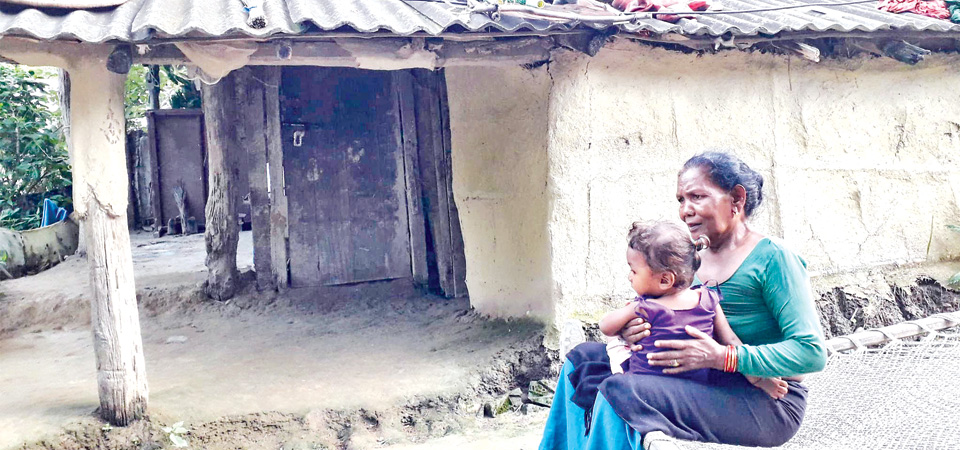Liberated, but still awaiting rehabilitation

By Abinash Chaudhary
Dhangadhi, July 17: Daily-wage labour was the only way to survive after emancipation. It was the only way she could keep the stove burning and feed her family. But little did freed Kamaiya Ram Kumari Chaudhary know that working would cause her to lose her chance at rehabilitation.
“The officers came to our settlement to register the Kamaiyas and provide identity cards when I was at work. So, I didn’t get registered,” Ram Kumari told The Rising Nepal. “Because of that, I didn’t get the land the government provided us (Kamaiyas).”
Ram Kumari used to work with her husband at her master’s house. They had to wake up when their master asked them to and could only sleep after they finished all the work their master wanted. The couple’s lives were dictated by their master. But all that changed when the government declared the Kamaiyas free. Ram Kumari and her husband, like all the other Kamaiyas of the country, were liberated from their bonds.
At the time, she was immensely happy. But that happiness has now turned to indifference. “The government declared us liberated on paper. But in reality, we are still bonded,” Ram Kumari, who does not feel any difference in her life as a Kamaiya and as a free woman living on unregistered (Ailani) land in the Radhakrishna settlement of Dhangadhi Sub-Metropolitan City–8, said. “The pain is still the same.”
Similarly, the family of freed Kamaiya Mina Chaudhary also lives on the Ailani land of Radhakrishna settlement because they did not receive the Kamaiya identity card. She, along with other Kamaiyas that live there, claim that the local government is conniving to remove them from the land they have been residing on for the past two decades.
“The ward claims that the land belongs to the Radhakrishna Temple and wants us to vacate it,” Mina expressed her grief. “Back when we were Kamaiyas, the landlords used to trouble us. Now, when we are free, the ward chairman torments us.”
The then His Majesty’s
Government freed the Kamaiyas from bonded labour on July 17, 2000 and announced that they would be rehabilitated as soon as possible. But 21 years on, many Kamaiyas like Ram Kumari and Mina are still forced to live in forests or on unregistered or public land waiting to be properly settled.
Kamaiya leader Bajari Chaudhary said that some vested interests had intentionally deprived the former bonded labourers of their registration documents. “People hesitated to stand as witnesses for the Kamaiyas in the registration documents. We also saw many cases of the registering agencies themselves try to talk people out of rehabilitation,” she shared her observations.
Bajari specifically named the organisation Backward Society Education (BASE), who came to Kamaiya settlements supposedly to help with their registration process, of playing with the Kamaiyas’ future and hurting their chances at proper settlement.
According to government statistics, there are 8,910 free Kamaiya families in Kailali with identity cards. As of the fiscal year, 8,546 families had been rehabilitated. But as per the Freed Kamaiya Society, an organisation that works intensively with freed Kamaiyas, there are 9,875 Kamaiya families in the district, of whom, 8,022 have been rehabilitated.
Furthermore, no work has been carried out to manage the freed Kamaiyas in the past two years. No family has been rehabilitated since the local and provincial governments took over the work from the Land Reform Office of Kailali.
Devendra Shah, officer of the Survey Section of the Ministry of Land, Management, Agriculture and Cooperatives of Sudurpashchim Province admitted that the ministry had not done much towards Kamaiya rehabilitation. “The ministry allocated a budget of Rs. 500,000 to collect the data of those who had not received the identity cards. Apart from that, the ministry has not done anything,” he informed.
Recent News

Do not make expressions casting dout on election: EC
14 Apr, 2022
CM Bhatta says may New Year 2079 BS inspire positive thinking
14 Apr, 2022
Three new cases, 44 recoveries in 24 hours
14 Apr, 2022
689 climbers of 84 teams so far acquire permits for climbing various peaks this spring season
14 Apr, 2022
How the rising cost of living crisis is impacting Nepal
14 Apr, 2022
US military confirms an interstellar meteor collided with Earth
14 Apr, 2022
Valneva Covid vaccine approved for use in UK
14 Apr, 2022
Chair Prachanda highlights need of unity among Maoist, Communist forces
14 Apr, 2022
Ranbir Kapoor and Alia Bhatt: Bollywood toasts star couple on wedding
14 Apr, 2022
President Bhandari confers decorations (Photo Feature)
14 Apr, 2022










